Documentation of labour and material needs is a critical aspect of monitoring a construction project. These files are necessary to keep the project on track against the project schedule and estimated cost. It is expected that this information is used and updated as the project progresses. The documents should be readily available and accessible on-site. Other important documents that must be kept on-site include the following:
- Permits
- Building contract
Organisations now make use of digital technology, applications, and software to streamline the preparation and compilation of site files in a construction project. For example, electronically prepared call forward sheets that allow for the worker or supplier follow-up with the click of a button makes the job of supervising a construction project easier and gives you more time to focus on other aspects of the project. Developers of such technology include Click Home and Companion Systems. Make sure to ask your organisation for access to such applications.
Electronic Call Forward Sheet
The construction project requires a steady and on-time influx of building materials. A call forward sheet is used to control the influx of materials by specifying the plan for the project's activities or tasks. Each activity would require materials to proceed on work. By using the call forward sheet, all material needs are organised according to its equivalent activity, allowing personnel to prepare and act on time:
Some information included in the call forward sheet include:
- Construction tasks
- Material notice date
- Material delivery date
- Material supplier of each task
- Contact information

Below is an example of a generic electronic call forward sheet:
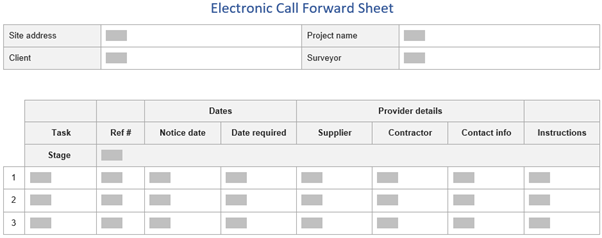
Inspection Checklist
A material inspection checklist is used for the quality assurance of the purchased construction materials. The document allows the procedural approach in evaluating the materials through a series of quality and quantity checks.
Quantity check refers to ensuring that the supplier can meet the agreed amount of material order, including the exact amount requested and determining material buffer. On the other hand, a quality check refers to assessing the ordered material's conditions if it meets specifications.
A sample generic material inspection checklist can be seen below:
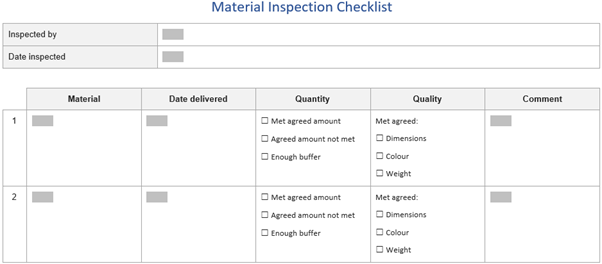
Procurement Specifications
The procurement of material and labour needs can be very exhaustive in detail, considering the massive number of transactions to be done with suppliers and contractors. A procurement specifications document is used to ensure the efficiency of the procurement process. In complete detail, this document provides the material or labour to be procured from a supplier or contractor.
Below are parts of a generic procurement specifications template:
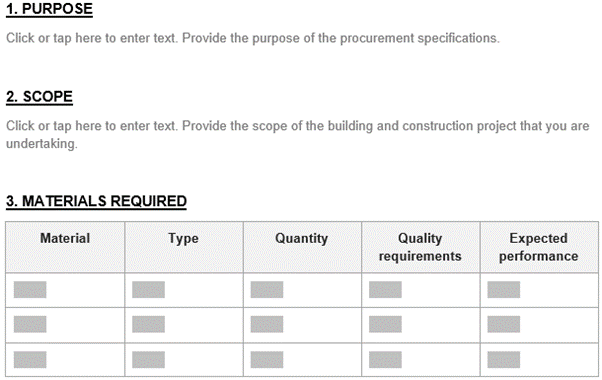
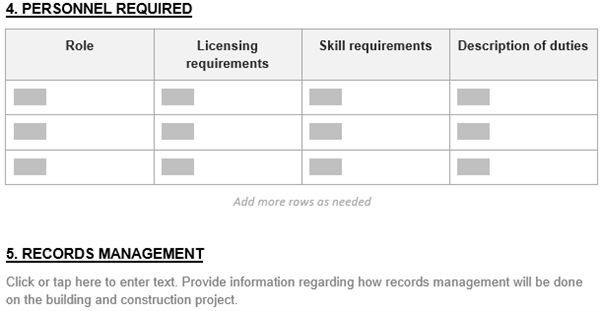
As observed in the example, the document allows the ease of quality and quantity control and requirements by providing the exact specifications asked for. The purpose of the document is to provide the supplier or contractor with the complete information of requirements that the supplier and contractor need to comply with.

A project is deconstructed into tasks across the different stages up to its completion to allow for precise management. Effective project planning starts from interpreting all the requirements from project conception to close-out, identifying everything needed, and preparing for undesirable outcomes. Each activity may require a specific time frame, need a definite quantity or quality of materials, or must be allotted a particular set of skilled labour. As the person in charge of labour and material schedules, you must balance these factors and act accordingly.
Breaking Project into Stages of Project Management
Stages of Project Management
Project management is a difficult undertaking. It is the balancing of project objectives, cost, and time in trying to achieve your goals. The project must be approached with a transparent perspective across the team, where cooperation and work execution determine project success. Planning requires the identification of the stages involved in a project. These stages outline milestones and provide general direction. Each stage can then be broken down into individual tasks or actions for easier project materials and labour allocation.
The following are the stages of project management in building and construction:
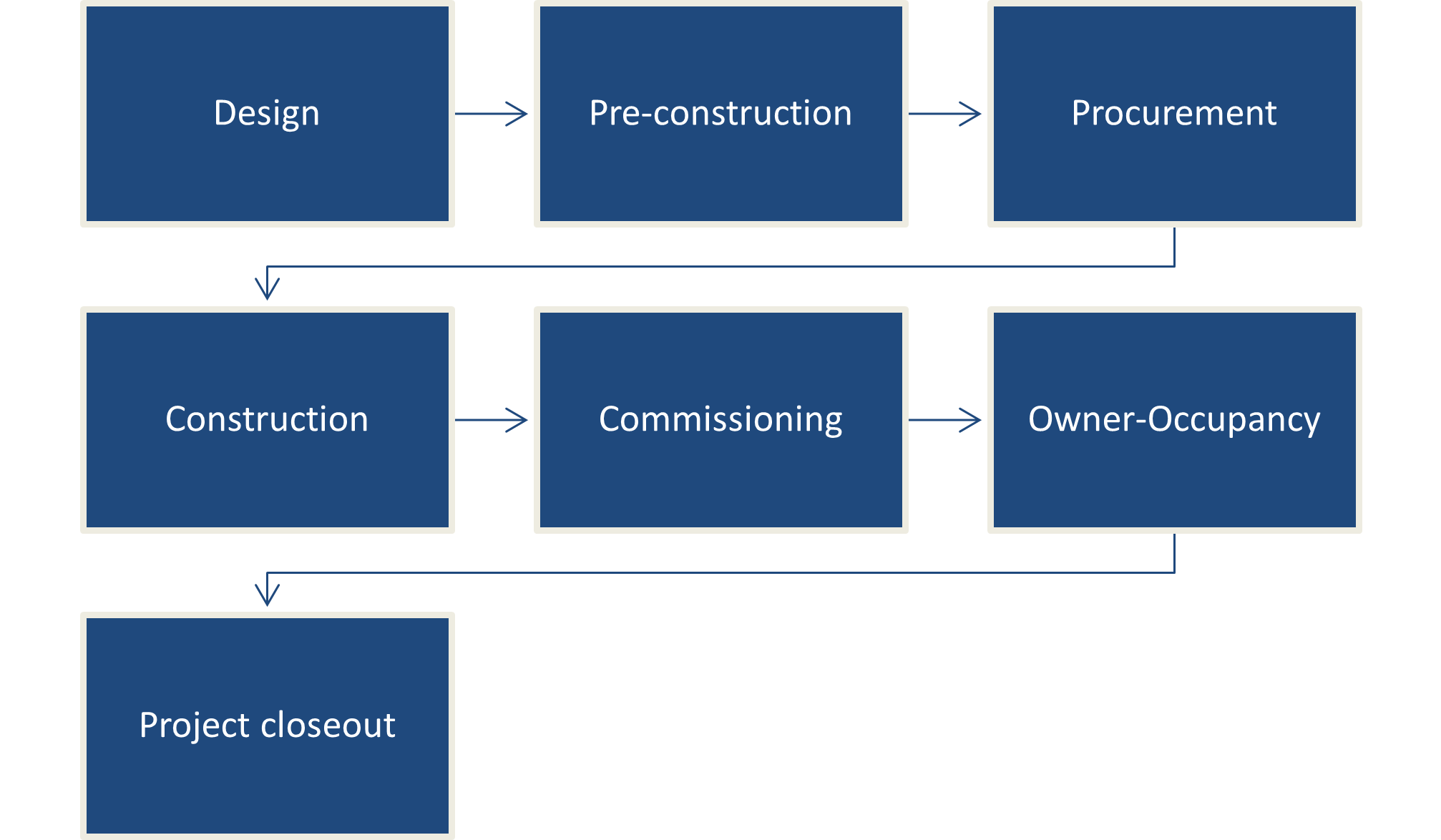
Design
The beginning of any construction project starts with the conceptualisation of a design. Through an architect or engineer, the building’s design is evaluated according to how achievable it is. The design is assessed based on current and relevant regulations and building codes. Once the procedure is completed, only then will the bidding process begin. Contractors are chosen according to the designs.
Pre-construction
This stage includes all preparations before the actual construction. It is also assumed that the bidding process has been completed and a contractor has been chosen. The contractor will then work with the contract administrator, project manager, field engineer, and superintendent, which forms the project team. Several site examinations are made to identify any possible problems encountered along the way and ensure that the site is ready for construction.
Procurement
Construction requires a lot of equipment, materials, and labour to proceed with the project. In the procurement stage, everything needed to complete the project is identified and purchased or settled. The difficulty of this phase relies on the expanse of the project and the company. And depending on this, the procurement process may hire labour and purchase materials on large or small scales.
Construction
Once all preparations have been made, the actual construction of the project will take place. Initially, the entire project team, including subcontractor and suppliers, finalise project rules and regulations. After which, temporary work facilities are secured, and safety policies established before the construction begins.
Commissioning
This is the transitional stage where the project team evaluates the building before turning it over to the owner. Operations and maintenance training is given to the owner’s personnel during this process.
Owner-Occupancy
The warranty period starts once the owner of the building moves in. The integrity of the project is tested as expectations outlined in the contract are placed.
Project Closeout
The last stage of the construction project usually settles any remaining contractual obligations. The team consolidates in creating a review of the project in terms and efficiency. The project issues and challenges are analysed, where conclusions are documented adequately for application in future projects.
Preparing a Schedule for a Building and Construction Project
Regardless of scale, construction projects need comprehensive and well-executed planning and scheduling to be successful and avoid a high margin of failure. There are many variables considered and factors that impact the project that can be overwhelming if carelessly approached. Construction project management uses tools that detail actions plans for cost, scope, time, and quality. The ideal planning and scheduling demand that resources, risks, and communications are accounted for to enable efficient workflow.
Project Schedule
The project schedule provides you and the project team a detailed overview of the scope of work, tasks, milestones, construction resources, and dates throughout the project life cycle. The amount of accuracy and detail of the project schedule directly affects its value. Significant time and patience are necessary to produce the most useful project schedule. Doing so means avoiding delays, maximising time as a resource, and preventing cost overruns.
Developing a Project Schedule
Organising the project team will benefit from a clear and concise project schedule. This enables everyone to picture an overview of the project and understand every aspect in detail. This timeline serves as a visual plan which distributes the project into smaller and more manageable tasks. Every task under progress or completed is reflected in the project plan and schedule, keeping everything organised. This system of facilitating the project allows for far greater control resulting in minimal problems or adjust before issues arise.
The project schedule incorporates communication with subcontractors, employees, and suppliers by giving their target schedules.

Guidelines for Completing a Project Schedule
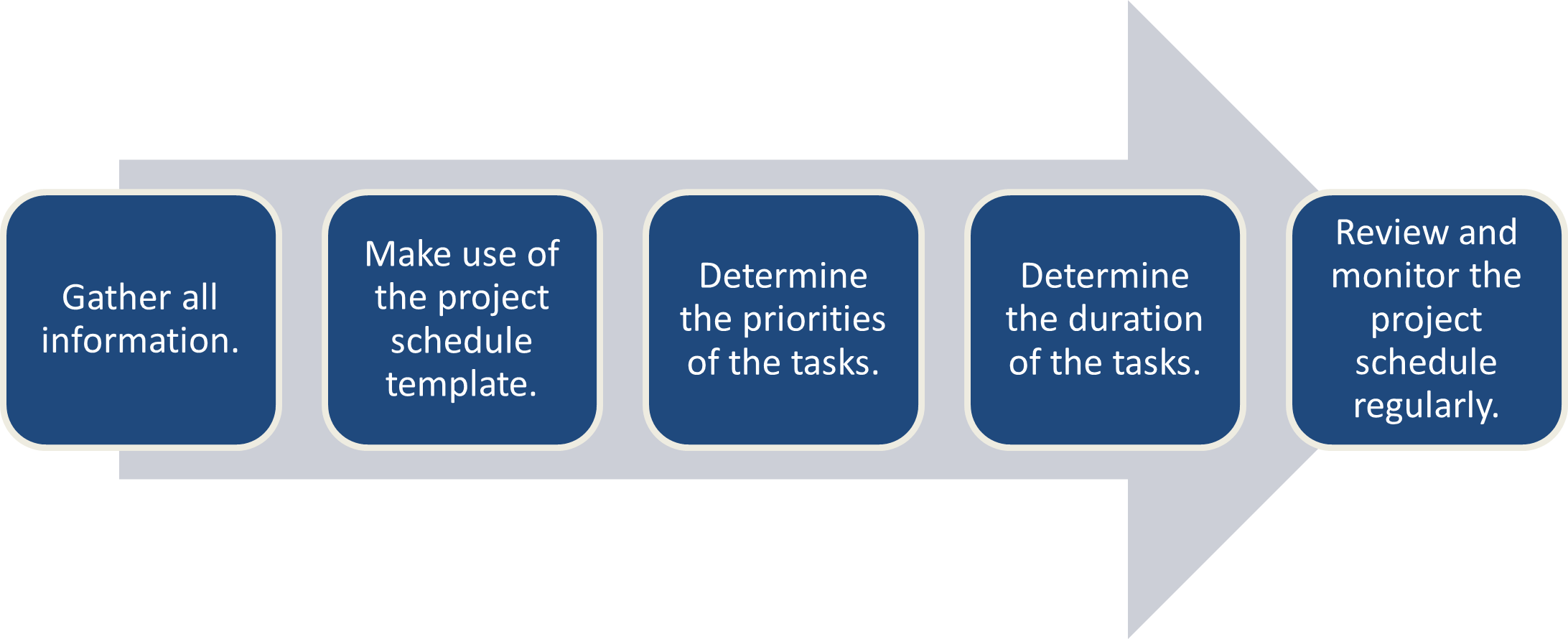
Gather all the information
The utility of a project schedule ultimately depends on the amount of information in it. Generally, the more information detailed in the project schedule, the better it can be used. That, of course, should be the aim while producing the project schedule. You can begin by listing all subcontractors involved in the project. By determining the approved suppliers and contractors and having them provide information such as the amount of time required to procure materials and delivery will serve as the backbone and directly affect your project schedule. These details allow on-point estimations.
Throughout the project, the schedule may include information about the requirements needed by local building codes and work health and safety. This also includes what inspections will take place throughout the construction.
The project budget also plays an important aspect when making the project schedule. It is crucial to determine the sources of funds and when these funds will be available. Information of funds may include cash flow.
Other information sources needed in producing a project schedule include call forward sheets, Work Breakdown Structure (WBS), and contingency plans.
Make use of the project schedule template
The project schedule can be encoded through your organisation’s project schedule template, which helps you broaden the structure of the plan. Usually, the document divides the project according to the project stages, wherein necessary information such as milestones and target dates are placed. Each project stage is detailed according to tasks or scope of work, where start dates and end dates are specified. Determining these will allow you to adjust your project schedule accordingly. Other information, such as materials and labour required for each task, should also be included as part of the project schedule.
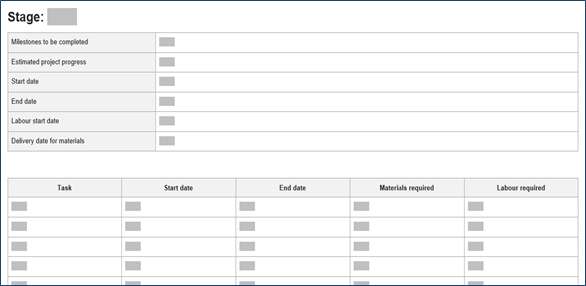
Part of the project schedule requires the determination of the scope of work by listing the tasks necessary for each stage of the project.
Determine the priorities of the tasks
With all the information gathered about the project, you can then categorise each task according to priorities. Attributing the expected duration of each task will substantially fill in your project schedule. Each task depending on scale and focus has different time requirements and determines these will impact your plan's accuracy.
You may make use of a WBS as an overview of the size and scope of the project. With this, you can account for all the tasks needed to achieve the project objectives. These tasks should then be placed in order and into manageable smaller pieces. The whole project can also be broken down into more extensive phases or milestones. A milestone signals a completion point in the project. Evaluating tasks will allow you to determine priorities.
Determine the duration of the tasks
The time given to finish each task should be realistic, where external factors are considered. The climate and weather, for example, can influence construction work, and it would be beneficial to look into historical data about weather. Another factor to consider would be holidays and leaves for employees as an added inclusion when adjusting your schedule.
When working with subcontractors and suppliers, consider that dates are subject to change. Ensure that your schedule can adjust to unexpected instabilities. Procurement is vital to the project, as the delivery of orders and reorders needs to be as fluid as possible.
Review and monitor the project schedule regularly
The project schedule, once completed, should always be subject to updating and adjustments. By monitoring and updating the schedule, you can determine the progress of the activities. Keeping track of the changes will keep the entire team in line with the project.
Determining the construction materials and labour required needed is integral for the project. These resources depend on the type of building to be constructed, wherein the most suitable materials are appropriated. Manpower must be identified and listed accordingly, ensuring the availability of each across the stages of the construction project. Throughout the phases of the project, a consistent stream of required materials is needed, and labour requirements may change depending on need.
Materials Required in Building and Construction
Materials in building and construction are the physical substances from which the building will be made from. The basic types of building materials used in construction are concrete, steel, wood, and masonry. These materials are classified according to their qualities in terms of strength, weight, durability, and costs. Because of this, certain materials are mandatory for specific purposes. Essentially, the materials used in a project are based on its costs and its ability to withstand the stresses acting on a structure.
Building materials are categorised into two. These are:
- Natural building materials, such as stone and wood
- Man-made-building materials, such as concrete and steel
The materials required for the construction project can be found in the construction drawings and specifications. When producing a project schedule, the necessary materials for each task in each stage should be specified. Below is an example of a generic project schedule template with input fields for the materials required for each task in the stage of construction.
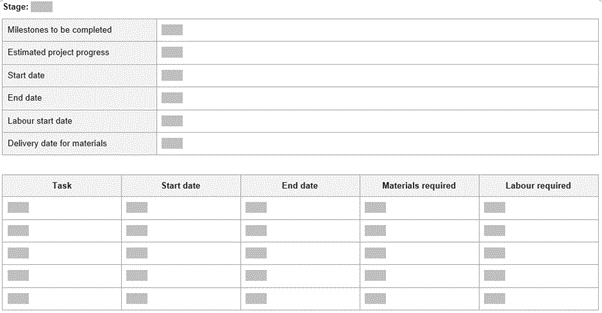
Labour Required in Building and Construction
Apart from materials, an essential factor that affects the cost of construction projects is the labour required to complete them. Labour cost includes their salary and may also cover accommodation, food, insurance cost, and other expenses. Labour requirements can be categorised into three types:
- Skilled labours
- Semi-skilled labours
- Unskilled labours
Employees in the Building and Construction Industry
Daily hire employee
The employment period of a daily hire employee is one day. They are considered full-time employees, and their employment may be terminated after providing one day’s notice.
Full-time weekly hire employee
Full-time weekly hire employees have guaranteed minimum weekly ordinary hours. They are entitled to longer notice of termination, with the specific amount of notice depending on the National Employment Standards.
Part-time weekly hire employee
The conditions and pay of part-time weekly hire employees are the same as their full-time counterparts, but the entitlements they receive are computed based on the number of hours they worked.
Casual employee
Casual employees have no guaranteed employment period. They also do not have any leave entitlements and usually have irregular hours.
The labour required for the construction project can be found in the construction drawings and specifications. When producing a project schedule, the labour required for each task in each stage should be specified.
Below is an example of a generic project schedule template with input fields for the labour required for each task in the stage of construction.
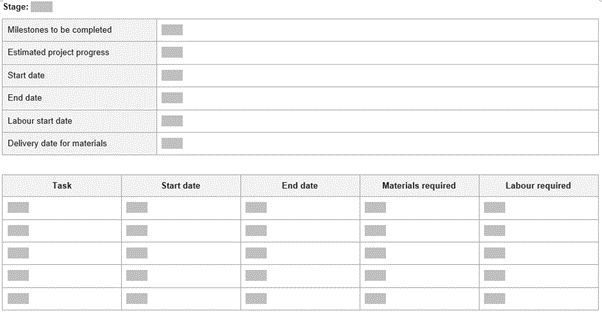
One’s perspective in managing material delivery date should be as precise as possible. Material requirements can be straightforward as a process; however, the size and variety of these needs can easily be mishandled if not approached systematically. Sequencing delivery dates should be reflected in the project plan. To sequence means to arrange delivery dates according to proper order and by the time particular materials are needed in a task. Labour should be arranged in the same way. Align labour required with each task or activity as indicated in a project schedule.
Material delivery dates and commencement times for labour should be coordinated to optimise resource-efficiency in terms of human resource and time. A construction worker’s workday is not only spent on productive tasks that advance the construction project forward. Often, their workday will also compose of unproductive tasks such as handling materials and waiting for the materials required for a task to be delivered. The goal of sequencing materials delivery dates and commencement times for labour is to reduce the amount of time spent on these unproductive tasks, reduce costs due to this unproductivity, and increase the project's productivity and sustainability.
Sequencing Material Delivery Dates
When deciding when materials should be delivered, you should refer to the schedule of the project stages and tasks broken down in Subchapter 2.2. An example of a generic project schedule template with the information required for this section of the unit is given below.
For each stage and task of the construction project, you should have determined the start date. Material delivery dates should correspond with these start dates. The materials needed for each stage should be available at the construction site by the time the project stage is set to commence.
Sequencing Commencement Times for Labour

When plotting out commencement times for labour, you should refer to the schedule of the project stages and tasks that were broken down in sub-topic 3.2 . Your focus should be on the same fields mentioned in the this section (i.e. the start dates of the project stage and tasks). You should also take note of the expected end dates of the stage before each stage. Scheduling for labour on a particular project stage to begin when the previous stage has not been finished yet will lead to unproductive time due to construction workers waiting for the previous project stage to finish.
The commencement times for labour should be in line with the delivery dates of the materials needed for a particular stage or task. Scheduling for labour to commence when the materials have not arrived yet, or several days after the materials have already been delivered, will lead to costs incurred due to unproductive time.
As the project plan and schedule are made, possible delays must be taken into consideration. Taking delays into consideration means that schedules should be realistic and, at the same time, aim to keep the project on track. There are several possible causes of delay in construction that the management team must always be alert of. Being unable to record any delays in project tasks can result in exponential consequences. In the event of a delay, the management must have prepared adaptive protocols to control the situation.
Causes of Delay in Building and Construction
Even with the intricate planning and scheduling of a project, delays may still happen. As discussed earlier, the project team must be flexible to adjust to these circumstances. Many variables and unforeseen factors hinder the progress of the project. Delay in construction may happen as time overrun beyond the target completion date in a contract or beyond the project's agreed-upon delivery date. Delays in the project could mean a loss of revenue for the owner, cascading from the unfinished work. This could also impact the contractor for delays and cause additional and higher overhead costs due to the extended period of work, fluctuating material costs, and increased labour costs. In can be concluded that being able to complete a project on time is a measure of competence. Within the project cycle, it is crucial to proceed with a calculated assessment to prevent delays or, if unavoidable, compromise practical solutions.
Delays in building and construction can be classified into the following categories:
| Client related causes | Labour and equipment causes | Contractor-related causes | Material-related causes |
 |
 |
 |
 |
| Design-related causes | External causes | Consultant-related causes |
 |
 |
 |
Dealing with Delays
Once a delay is detected, countermeasures should be initiated to stop or limit losses. The following are recommended approaches in dealing with the setbacks:
- Investigate the source of the delay before taking action.
- Inform the people or groups in the project that caused the delay and encourage cooperation in coping with the problem.
- Develop and proceed with a plan of action by reviewing original plan and member roles and begin prioritising activities that are prone to further delays.
- Involve others in developing a solution by gathering helpful suggestions and ideas.
- Monitor progress as the team adapts to the new plan.
- Maximise the new schedule by fast-tracking on remaining tasks.

Establishing Protocols for Delivery Delays
There can be situations when the supplier cannot meet delivery dates which could develop into further issues. As the person in charge of material scheduling, you should act according to an agreed procedure for delivery delays. Getting to the root of the delay is a significant concern, but the priority should be to evaluate how a delay would impact the construction activities. Analysing the impact of the delay can direct the management in making the necessary adjustments. New delivery dates should be scheduled, paired with consistent follow-ups. If possible, provide the supplier with helpful feedback and work together in understanding the cause of the delay. Clear expectations must be ascertained with a supplier, and clear consequences should be set.
Although delays in construction projects are possible, there are ways to lessen their effects before they occur, which include:
- The project plan and schedule should be realistic and reasonable for both the team and the clients.
- The project plan should be complete in detail in providing as much information as possible. A well-made plan supplements better solution as project delays are being projected.
- Accustom everyone to understand their roles and responsibilities before the project commences.
- Ensure that the labour acquired is well-experience with their respective tasks.
- Establish effective communication with everyone that encourages transparency of work and progress.
- Continuously improve project management/processes.


